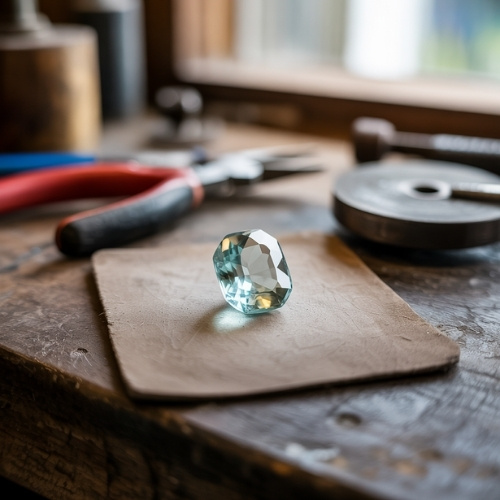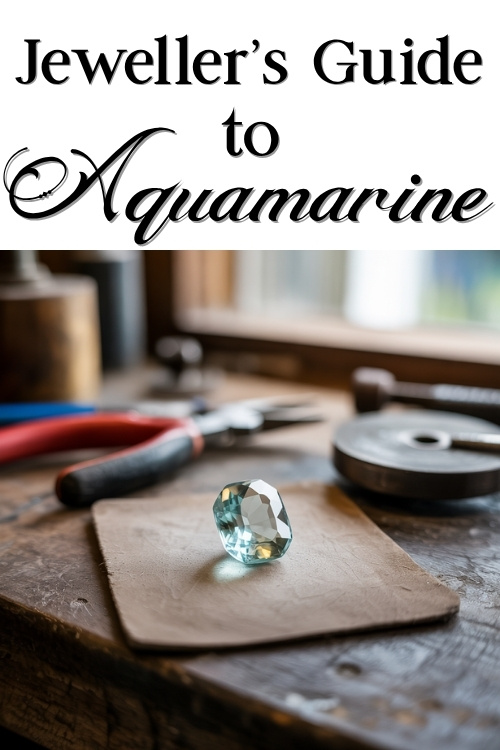Estimated reading time: 4 minutes
Aquamarine glows with the stillness of ocean depths. Cool, clear, and quietly radiant. Its name evokes sea water, and its hues range from delicate sky blue to deeper marine tones that stir a sense of calm. Long favoured by jewellers for its clarity and poise, aquamarine is more than just beautiful, it’s a dependable, versatile stone that brings an easy elegance to your creations.
Jump to:
Basic Identification Information
Name & Synonyms
Aquamarine; sometimes referred to as “sea water stone” in cultural traditions.
Species
Beryl
Colour Range
Blue to greenish-blue
Refractive Index
1.577–1.583
Birefringence
0.005 to 0.009
Optical Sign
Uniaxial –
Pleochroism
Ranges from weak to moderately strong and shows 2 colours.
Blue and Colourless, or Blue and Greenish-blue, or two shades of Blue.
Specific Gravity
2.67–2.90
Fluorescence
None
Lustre
Vitreous — a glass-like shine when polished
Clarity
Type I
Typically eye clean
Gems Often Mistaken For
Apatite, spinel, topaz
Mohs Hardness
7.5 to 8
Wearability
Generally good; stable for most jewellery use but can fracture if struck
Spotting Synthetic (Lab-Grown) Aquamarine
Lab-grown aquamarine is rare in the market, as natural material is widely available and relatively affordable. When it does appear, it typically mimics the cleaner end of aquamarine’s colour and clarity range. Gemmological tools such as spectroscopy or advanced magnification may be needed to confirm origin, though inclusions can sometimes offer clues. Natural aquamarines may show fine tubes or growth features, while synthetics tend to appear flawless.
Common Treatments
Nearly all aquamarine on the market has been heat treated. This is a stable, accepted enhancement that gently removes the greenish tint to bring out purer blue tones. This process is permanent and does not affect the gem’s durability or value.
Durability & Setting Considerations
Aquamarine is a dependable gem for most jewellery types, with enough hardness and toughness to suit rings, earrings, and pendants. It has no cleavage, which makes it resistant to splitting, but natural fractures can chip if exposed at vulnerable angles.
Set aquamarines in protective designs, such as bezels, recessed settings, or raised galleries with secure prongs. Be mindful when polishing after setting as excess heat or pressure can affect both colour and structure.
Avoid high-heat procedures like casting in place, as aquamarine cannot tolerate the temperatures involved.
🛍️ Explore our selection of pre-owned Aquamarine Gemstones for your next jewellery creation.
Care Instructions
Cleaning
Use warm water, mild soap, and a soft brush. Avoid steamers and ultrasonic cleaners, as they can weaken the stone over time.
Storage
Store aquamarine separately from harder gems like sapphire or diamond to avoid scratches. Keep it in a fabric-lined box or pouch to protect it from abrasions.
Daily Wear
Aquamarine holds up well with care, but when set into a ring or bracelet, it benefits from being removed prior to manual work.
Market & Ethical Notes
Aquamarine is widely available and relatively affordable, especially in lighter tones. Deeper blues with excellent clarity attract higher values.
Brazil remains the most prominent source, though Nigeria, Pakistan, and Madagascar also yield high-quality gems.
Ethical sourcing is generally straightforward with aquamarine, and many suppliers offer traceable origin stones. Its availability in larger sizes and high clarity makes it popular among both jewellers and collectors.
🔗 Learn more about the ethical and environmental story behind Reclaimed and Recycled Gemstones.
Symbolic & Spiritual Meanings
Known as the “stone of courage,” aquamarine has long been linked to the sea and sailors. It’s said to protect voyagers and calm stormy waters, both literally and emotional. It’s associated with clear communication, soothing anxiety, and opening the throat chakra.
Whether worn as a talisman or chosen for its beauty alone, aquamarine carries a tranquil, steady energy that’s hard to ignore.
🔗 Dive deeper into Aquamarine’s Symbolic & Spiritual Meanings
Etymology
The name aquamarine derives from the Latin aqua marina, meaning “sea water.” Though popularised in Europe during the 16th century, the gem itself has been known and loved since ancient times.
🔗Curious about how aquamarine was viewed in ancient cultures? Explore its fascinating myths and legends
📌 Save this jeweller’s guide to aquamarine for quick reference next time you’re working with this stunning gem.


